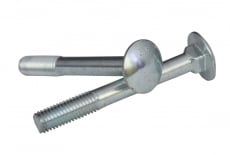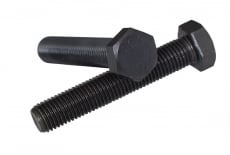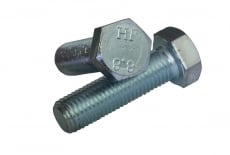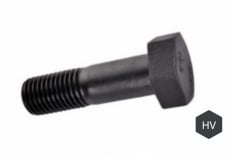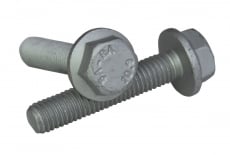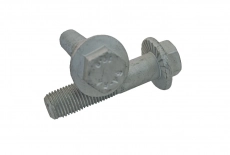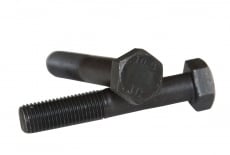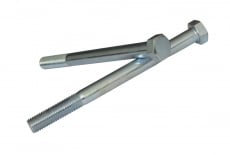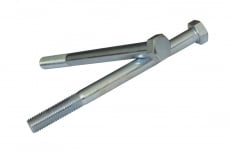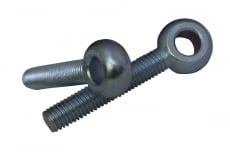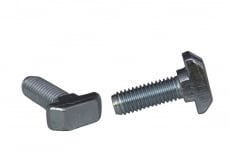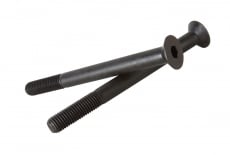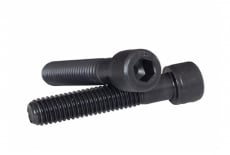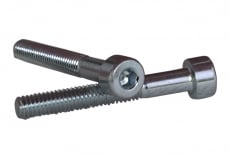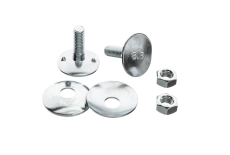How to determine the strength class of bolts
The strength class of bolts is usually determined by their standard designation, which is indicated on the bolt head or on the packaging. For example, a bolt may be rated 8.8, 10.9, or 12.9, which indicate its strength and tensile strength. The mechanical properties of bolts made of carbon unalloyed and alloyed steels according to GOST 1759.4-87[12] (ISO 898/1-78) under normal conditions characterize 12 strength classes: 3.6; 4.6; 4.8; 5.6; 5.8; 6.6; 6.8; 8.8; 9.8; 10.9; 12.9; 14.9. The first number multiplied by 100 determines the nominal temporary resistance in N/mm², the second number (separated by a dot from the first), multiplied by 10, is the ratio of yield strength to temporary resistance in percent. The product of numbers multiplied by 10 determines the nominal yield strength in N/mm².
High strength includes bolts starting with strength class 8.8. Strength characteristics are determined by the appropriate grade of steel and bolt manufacturing technology. Therefore, before using bolts, it is necessary to carefully check their strength and stability in specific conditions.
Marking of the strength class of metric bolts according to DSTU ISO 898-1-2014
According to DSTU ISO 898-1-2014, the strength class of metric bolts is indicated by a numerical combination consisting of two numbers separated by a dot. Also, according to DSTU ISO 898-1-2014, there are also bolts with an increased strength limit, which are marked with the symbol "10.9S" or "12.9S". For these bolts, the minimum tightening torque is increased by 25% in accordance with the minimum tightening torque for ordinary bolts of strength class "10.9" or "12.9".
SAE J429 inch bolt strength class marking
Usually, the marking on the bolt head allows you to determine its class or strength. USS or SAE bolts are classified from Class 2 to Class 8 depending on their strength, which is measured in inches. The higher the class, the stronger the bolt. To determine the class or strength of English bolts, radial lines are placed on the head. The number of lines on the head is 2 less than the actual strength rating. For example, a grade 5 bolt will have 3 radial lines on the head, and a grade 8 bolt will have 6 lines.
The strength classes of inch and metric bolts do not always correspond to each other because they are measured in different units. In the metric system, strength classes of bolts are indicated by numerical values, for example, "8.8", "10.9", "12.9". These values indicate the minimum bolt strength limit in newtons per square millimeter and the minimum bolt torque in newton meters required to provide maximum bolt strength.
In the inch system, the strength classes of bolts are indicated by letters and numerical values, for example, "Grade 2", "Grade 5", "Grade 8". These designations indicate the minimum bolt strength limit in kilo-pounds per square inch and the minimum bolt torque in pound-feet required to provide maximum bolt strength.
There is a table that indicates the correspondence between the strength classes of inch and metric bolts. For example, Grade 5 is roughly equivalent to Grade 8.8, and Grade 8 is roughly equivalent to Grade 10.9. However, it is important to remember that the exact fit may depend on the specific standard and bolt manufacturer.
Strength classes, materials, characteristics and fields of application of bolts
The strength class of a bolt is determined by its minimum strength limit and indicates its ability to carry loads during tension. The higher the tensile strength, the greater the loads a bolt can withstand, making it ideal for high-stress applications such as industrial equipment or fastening heavy objects.
There are different classes of high-strength bolts, including:
- Grade 8.8 Bolts: These are often used in construction and are made of multi-coated steel.
- Grade 10.9 Bolts: These bolts are often used in the automotive industry and are made of boron or carbon steel with a high tensile strength (1040 MPa).
- Grade 12.9 Bolts: These bolts are used in industry and construction to connect medium to heavy parts such as automotive engines and are known for their strength.
- Grade 14.9 Bolts: These are the strongest bolts that can be used, they are ideal for connecting large structural members and have a huge maximum tensile strength (1400 MPa).
The main materials used to make bolts include carbon and alloy steel, stainless steel, polyamide, brass and other alloys. The choice of material depends on the strength requirements.
GOST and DIN bolt standards by strength classes
| Клас міцності | DIN | ГОСТ |
| 5,8 |
ГОСТ 7805-70 ГОСТ 7808-70 ГОСТ 7795-70 ГОСТ 7796-70 ГОСТ 7798-70 ГОСТ 15589-70 |
|
|
8,8 |
ГОСТ 7805-70 ГОСТ 7808-70 ГОСТ 7795-70 ГОСТ 7796-70 ГОСТ 7798-70 ГОСТ 22353-77 |
|
| 10,9 | ГОСТ 22353-77 | |
| 12,9 |
FAQ
What strength class of bolts is better?
The choice of bolt strength class depends on the specific application. The main strength classes of bolts include class 4.6, 8.8, and 10.9. Grade 4.6 has a minimum tensile strength of up to 400 N/mm², while Grades 8.8 and 10.9 have higher tensile strengths of up to 800 N/mm² and 1000 N/mm² respectively. The choice of strength class should ensure the required level of strength and reliability of the connection high-strength bolts.
What does strength class 10.9 mean?
Strength class 10.9 refers to metal bolts, screws and other fasteners and shows their strength. This strength class means that the material has a minimum tensile yield strength of 1000 MPa and a minimum tensile strength of 1090 MPa. This means that such elements can withstand significant loads and are used in areas where reliability and fastening strength are important, for example in mechanical engineering and construction.
What are the strongest bolts?
The strength class of bolts is determined by their ability to withstand loads during stretching or bending. Typically, bolts have a strength class from 4.6 to 14.9, where a higher class indicates greater strength.


 Bolts (20)
Bolts (20)